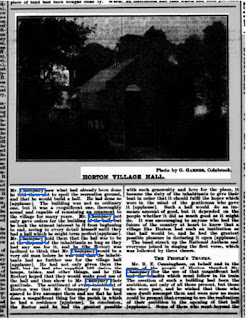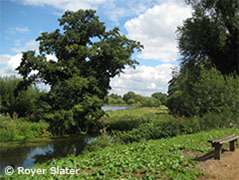A potted history of Champney Hall and the Recreation Ground
1905
Land Purchase. (Of what is now Champney Hall and the Recreation Ground)
In 6th June 1905 the land was sold by the executors for the estate of General
Owen Williams. It formed Lot 14 in the sale of 1,215 acres within
Horton. The lot was purchases together with Lot 18 (Horton Cottage) by
Mr. John Edward Champney, a benevolent Quaker who lived in the cottage till his death in
1929
1909 Purchased by Public Subscription (Site for a Village
Hall)
Lot 14 formed two parcels of land. The plot to the east was purchased for
a nominal amount from Mr. Champney about 1909. Funds being raised by
public subscription for the site of a Village Hall
Circa 1910/11
Mr. Champney observed that despite considerable effort fundraising to cover
building cost was progressing slowly. He also observed that the children of the
village were making full recreational use of the ground. He and his wife
therefore decided that they would donate the second parcel of land within Lot
14 and would also build on it a Village Hall.
22nd October 1913 - Opening of a Village Hall.
An extract from the press report of the Opening of the Hall on 22nd October
1913 states the
Rector said . . ."for many years past the people of Horton have been dreaming
about a village hall..... Mr. Champney came to the rescue with a promise that
he would build that hall, before he made that promise he saw that the people of
Horton were in earnest in trying to raise funds."
Mr. Champney stated
that he “made that promise because he did not wish to spoil the enjoyment he
had observed by those using the area as a recreation ground"
(Note: Local memories state that Mrs. Champney made the curtains herself and
personally donated the full sized snooker table that used to be in the rear
hall. The rear hall was apparently an after-thought built some months
later We understand that Mrs Champney took the view that the men
needed a place of their own away from the children.)
Local resident Joan Mildenhall wrote (in October 1986)
The Champney Hall was built on land owned by Mr Champney and paid for him only for the men and boys of the village at first, and later shared by everyone. Mr Champney thought that the women and girls should stay at home!
Christie Willetts wrote this for a Village Fete programme:
Horton was exceptionally fortunate that it was acquired by Mr John H Champney, a very benevolent gentleman. He realised that village life could be greatly enriched if there were a village hall and in 1911 he joined with the rector of Horton and Mr Cunningham, of Horton Manor, acting as trustees to buy (for £85) the present recreation ground as a site for a village hall. Mr Champney soon felt it would be better to leave that field, of about an acre, as a recreation ground and he generously promised to build a hall on adjacent ground. This he promptly did.
For more documents see end of this article
Death of Mr. Champney 1929
In his will dated 13th November 1926 Mr. Champney left an endowment of £1,200 to the YMCA to cover maintenance, upkeep and improvement of the hall
Notes made in 1980 by a parish Councillor state that "The Parish Council at the time used the School House and their view was the Village Hall was for the 'workers recreation and social welfare'.
A copy of his will is available from the Gov probate search service. The link is https://probatesearch.service.gov.uk/#calendar and the cost (at the time of writing) was £1.50. To complete the form you will need the following information (folio 742):
(Note:
Verbal history states that the reason the hall was donated to the YMCA was because
Mr. &. Mrs. Champney were Quakers and had a disagreement with
the Vicar because he spend a considerable time in the local 'public
houses' when he should have been administering to his flock).
Horton Cottage
Title records also show that in his will Mr. Champney also instructed that his
dwelling known then as Horton Cottage be used as a "Home of Rest"
Later known as the "Gardeners Home" which in the 1970 became offices
for Lloyds Bank with Dawn Redwood Close being built on the orchard to the
rear. The original but extended building being demolished and
rebuilt in 2003/4 . The Caretakers cottage is now known as
“Freshfield”.
Champney
Hall 1913 to 1974
Information gained shows that the hall was well used by the community, it also
served as the sports hall and dining room for the village school, a doctors
clinic and baby clinic. These all closing together with the village
school about 1974. This loss of community provision appears to be the
result of the change in local authority from Buckinghamshire to Berkshire.
1970/73 Files
Files held by Bucks Education Dept relating to the transfer from Bucks to Berks
County Council, indicate that the hall did not meet current education
requirements and was in need of considerable internal and external repair.
1975 - 1980
Records show that during these years a small committee of residents continued
to manage the hall but although the hall was still well used, it was not
covering running costs and funds to upgrade were difficult to obtain. A
number of public appeals were made with little or no response or interest from
the village as a whole.
Early 1980
Betty Marlow, Barbara Hearne and others with young children applied to start a
number of clubs for children/ young people in the hall. Legislation
having moved forward prior to starting they were required to obtained a Fire
Officers report. Unfortunately the Fire officer declared the hall a fire
risk and instructed instant closure for public events (excluding meetings)
As the Hall was legally held by the YMCA they had to be consulted.
Although the hall had always been locally managed, the YMCA instructed that a
new committee be formed and an improvement plan put in place.
New Management members were appointed: Richard Tillyer, Betty Marlow, and Clive
& Barbara Hearne alongside previous members David Bartram, Bob Spennywyn,
Michael Ardley and June Lucas.
During the next two/four years over 40K was raised through loans and grant aid
allowing the hall to redesigned and upgraded. Through the efforts of Richard
Tillyer national companies also contributed manpower or materials.
1985 YMCA changes - Proposal to Sell
Unfortunately in 1985, due to a change within the charitable structure of the
YMCA, the custodianship of holding the hall in trust fell outside their
charitable remit and an application was made to sell the hall. The
local committee after much discussion with the YMCA agreed to go to the Charity
Commission to see if a compromise could be reached.
1987/88.
Over the next two years suggestions and possible charity schemes were discussed
and rejected, but a solution was found on 12th November 1988
1989
New Charity Scheme
On the 4th January 1989 a scheme was sealed by the Charity Commission where 5
residents of Horton (Richard Tillyer, Betty Marlow, Clive Hearne, Bob Spennewyn
and David Bartram) became the managing trustees for one year. They also
committed that at the end of that year a full management committee would be
established. All five provided personal financial guarantees thus
accepting a considerable personal financial liability to ensure Horton retained
a Village hall.
1990
Full Charity Scheme established.
(a) The Parish Council by formal
resolution would act a Custodian Trustees and underwrite any losses.
(b) A Committee of Managing Trustees as detailed within the scheme was
established.
1991
to 2016.
Since 1991 Managing Trustees have come and gone, some were very committed and
others helped as and when they could. Through their collective efforts
the hall is currently well maintained and covers its running costs. Two
of the original trustees still remain and have been supported since 1993 by
Freda Bovington. During this time Samantha Beldom took on cleaning, then
bookings and then invoicing responsibilities.
Trustees
for Life
A public meeting in 2000 wished to recognise the dedication of the remain two
trustee and passing a resolution to amend Clause 7 of the Charity Scheme
and appointed Mrs Betty Marlow and Mr Richard Tillyer as Trustees for
Life.
Betty Marlow prepared this above potted history of Champney Hall on the halls 101st birthday to ensure that its history is not lost
2016
and forwards
Sadly Betty Marlow died in 2016. Without the commitment of Samantha
Beldom the day-to-day running of the hall would not work as smoothly as it
does. A new committee was established comprising of the original stalwarts
Richard Tillyer and Freda Bovingdon, plus Stuart Ingar, Samantha Beldom and
Benta Hickley. If anyone is interested in joining the committee or can
offer any assistance please do not hesitate to email ChampneyHall@gmail.com
What
is the Future?
Village life has also changed, legislation for public buildings has become
complicated and expensive, and the original social needs for the hall have
declined.
Unfortunately Champney Hall never has nor never will be able to complete with
its near neighbours. To remain financially viable Champney Hall does not
have the income to pay full time caretakers or repair companies. It will
always need "can do" volunteers and they are very hard to find. If
you can attend a meeting every few months, or have the time or commitment to be
on call 24/7, or anything between, please let us know.
2020 and forwards
Stuart Inger has put in a huge amount of work ensuring the fire detection system and the electrical systems is up to date and ensuring regular inspections are carried out as well as running the accounts and ensuring bills are paid etc. He moved out of the village early 2021 and therefore left the Committee. Sadly Richard Tillyer passed away in 2024.
As of spring 2024 there is a committee of the following: Jayne (Chair), Benta (Clerk), Carly (Treasurer), Daveena and John (Facilities and statutory inspections), Sam (Bookings) and Freda. Regular hirers are also invited to committee meetings. The committee aims to meet about 4 times a year
The Committee volunteers can be contacted by email: ChampneyHall@Gmail.com
In the news
Newspaper articles regarding the opening of the hall: Click on the image to enlarge. Unfortunately they are poor quality

















